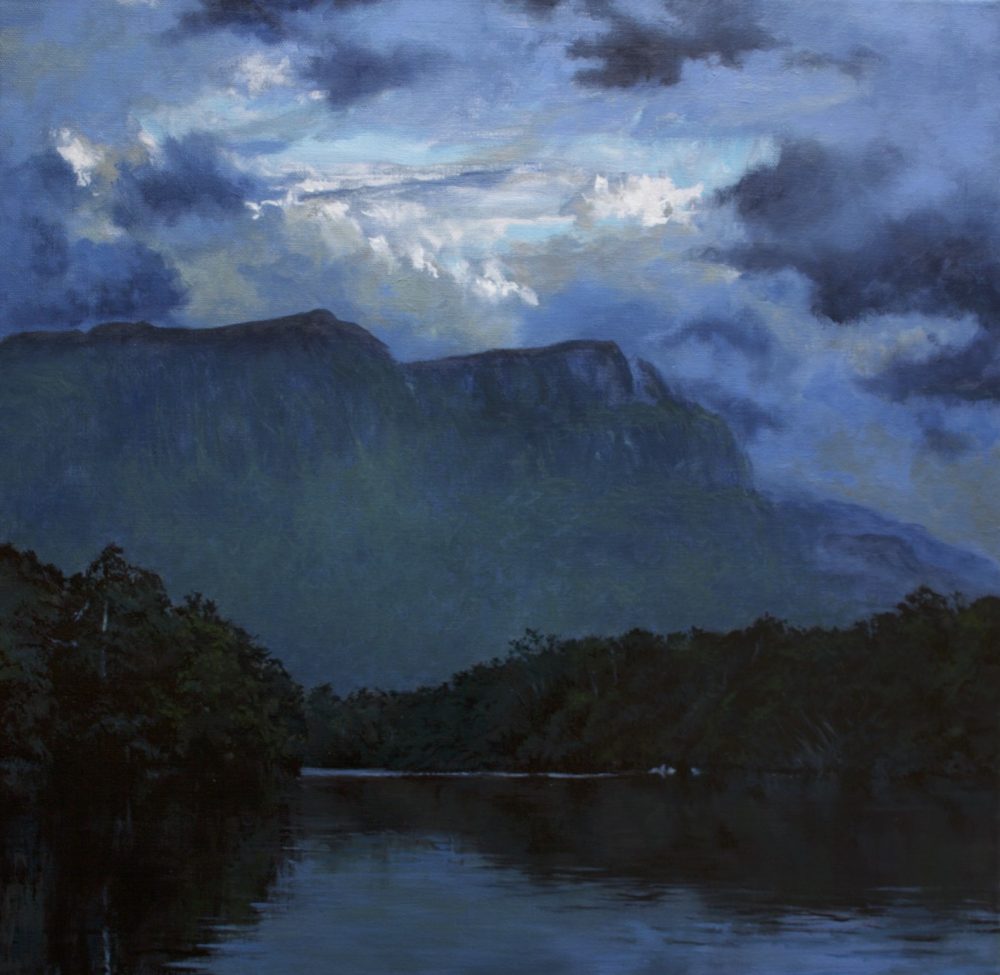« La nuit tombe lentement, le voyageur a marché longtemps en terre inconnue pour se retrouver face au monde qui apparaît dans les tableaux de Guillaume Montier. Voir les tableaux de Guillaume Montier, c’est être saisi par une rencontre, s’arrêter et observer longuement. Observer longuement une fiction qui met en scène l’inquiétude face à l’inconnu des paysages et des figures humaines, plutôt rares, qui parfois apparaissent. Aucun sentier n’existe sur la carte pour le conduire là où il s’arrête le corps fatigué et fébrile. Il a dû se frayer un chemin parmi les herbes hautes pour croiser un jeune homme torse nu dans « Constellation », défier la végétation envahissante pour surprendre « L’homme doré », il a emprunté parfois les ailes d’un oiseau ou ramer sur une mer démontée pour observer le récif de « Terra incognita ». Le regard craintif est à juste distance du danger possible, c’est une halte d’éclaireur, les yeux aux aguets. La tension est picturale, les nuances sont sourdes, les tons crépusculaires : noir de mars, terre de Sienne brûlée, violet de cobalt, bleu indigo. La peinture est précise, bien qu’affranchie des contours, elle alerte celui qui s’aventure : les projections de l’eau sur le corps sont électriques, les crêtes montagneuses sont tranchantes, les nuages crépitent au soleil couchant comme autant de signaux de détresse.
Pour s’approcher du jeune homme assis dans la rivière, le voyageur doit franchir la rivière et c’est bien les pieds dans l’eau qu’il le regarde. La posture est instable, il est entré dans le paysage, il fait parti du décors mais le regard se porte de biais. Une inclinaison qui met en scène une observation discrète presque timide. Parfois, et c’est rare, le sujet arrive de front. Dans le tableau « Paradis », un homme fait face gaillardement assis sur la barrière, alors le peintre est en léger contrebas, impressionné mais téméraire. Dans la rivière, la scène est belle, sensuelle mais sans excès, pudique. L’homme de l’eau est beau, musclé, il se détend. Il offre sa nuque à la violence du cours d’eau. Le fardeau qui pèse sur ses épaules semble lourd. Adossé à la roche, son corps est, enfin, relâché. Le bruit est assourdissant, l’homme, la tête inclinée en avant, a les yeux fermés, il n’a pu ni entendre ni voir l’approche. Il demeure dans ses pensées. Fascinants, les tableaux de Guillaume Montier mettent en scène cette approche « hors cadre ». A pas mesurés, le regardeur arrive dans sa peinture. La force tremble sous les couches de couleurs, le monde vibre dans ses reliefs mais ici c’est la délicatesse des aplats et l’humilité des formats qui surprend. Le peintre hésite, montre le doute, cherche, et se repose sur la lumière. Les paysages qui sont peints, peut être réels, ressemblent à ceux des mythes mais les mythes sont des légendes et les légendes sont des illusions. De quelles légendes faut-il se méfier ou s’inspirer pour respirer ? Pour avancer ?
Trouver la source de la lumière dans les tableaux de Guillaume , c’est déjà trouver la piste à poursuivre, à inventer. Un chemin sans origine qui guide sa destiné. »
— Aude Lavigne.

Dans le plus grand silence – Oil on canvas – 50x50cm – Private collection
Night is slowly falling; the traveller has walked a long way in unknown territory to finally find themselves face to face with the world appearing in Guillaume Montier’s paintings. Seeing his paintings means being overcome by an encounter, stopping and observing for a long time; observing for a long time a fiction which features the unrest concerning the unknown dimension of the landscapes and the few human faces which appear here and there. There is no path on the map to show them the way to where they should stop; their bodies, weary and feverish. They had to make their way through tall grass to bump into a bare-chested young man in Constellation, to defy the thick vegetation and catch the l’homme doré (Golden Man). They sometimes borrowed a bird’s wings or rowed on a raging sea to contemplate the riff of Terra incognita. Watching in fear, they are just far enough from the potential danger, stopping on their way just as a scout would, keeping their eyes peeled. The tension is of a pictorial nature, the shades are dull and the tones are dusk-like: mars black, burnt sienna, cobalt violet, indigo blue.
The painting technique is precise although free from outlines; it alerts anyone venturing into it: the water projections on the body are electric, the mountain ridges are sharp; at sunset, clouds crackle as a multitude of distress signals.
To get closer to the young man sitting in the river, the traveller has to cross it and looks at him while standing in water. The posture is unstable, they got into the landscape, they are now part of it, but looking sideways. A tilt which represents a discreet, almost shy observation. Sometimes, and on rare occasions, the subject is directly facing forward. In the painting Paradis (Paradise), a man is facing the viewer, cheerfully sitting on a fence, the painter being slightly beneath him, impressed but reckless. In the river, the scene is beautiful, sensual without being too much – modest. The man in the water is handsome and muscular, he is winding down. He is offering his neck to the violence of the waterstream. The burden on his shoulders seems to be heavy. Leaning against the rock, his body is finally relaxed. The sound is deafening. The man, his head bowed forward with his eyes closed, could not see nor hear the traveller approaching. He is still deep into his thoughts. Guillaume Montier’s fascinating paintings stage this out-of-frame approach. With measured steps, the watcher comes into his painting.
The paintings quiver with power underneath the different coats of colors, the world vibrates in the landscapes, but what is surprising here, is the delicacy of the swatches and the humility of the formats. The painter hesitates, reveals his doubts, searches and relies on light. The painted landscapes may be real and look like those in myths, but myths are legends and legends are illusions. Of which legends should we be wary, which ones should inspire us to breathe? To move forward? Finding the source of the light in Guillaume’s paintings already means finding the direction to be pursued, to be invented; a path without any origins guiding its fate.
— Aude Lavigne
